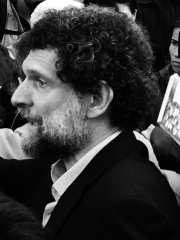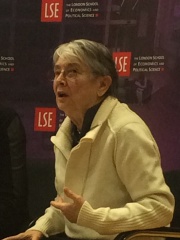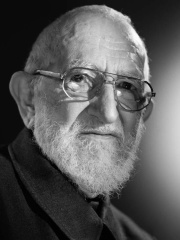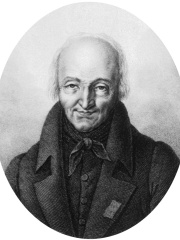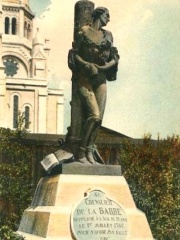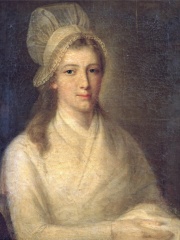
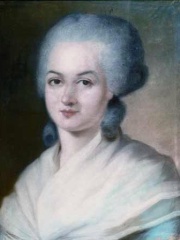
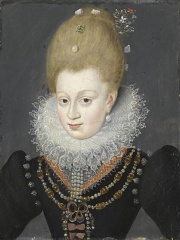
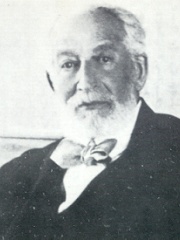
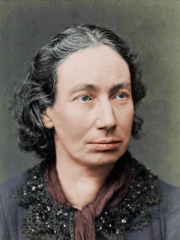
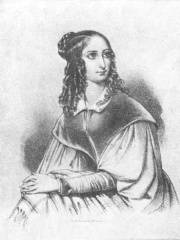
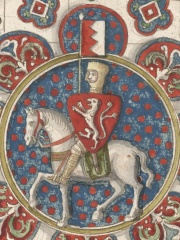

The Most Famous
SOCIAL ACTIVISTS from France
This page contains a list of the greatest French Social Activists. The pantheon dataset contains 538 Social Activists, 24 of which were born in France. This makes France the birth place of the 6th most number of Social Activists behind Russia and Germany.
Top 10
The following people are considered by Pantheon to be the top 10 most legendary French Social Activists of all time. This list of famous French Social Activists is sorted by HPI (Historical Popularity Index), a metric that aggregates information on a biography’s online popularity. Visit the rankings page to view the entire list of French Social Activists.

1. Charlotte Corday (1768 - 1793)
With an HPI of 72.82, Charlotte Corday is the most famous French Social Activist. Her biography has been translated into 48 different languages on wikipedia.
Marie-Anne Charlotte de Corday d'Armont (27 July 1768 – 17 July 1793), known simply as Charlotte Corday (French: [kɔʁdɛ]), was a figure of the French Revolution who assassinated revolutionary and Jacobin leader Jean-Paul Marat on 13 July 1793. Born in Normandy to a minor aristocratic family, Corday was a resident of Caen and a sympathizer of the Girondins, a moderate faction of French revolutionaries in opposition to the Jacobins. She held Jean-Paul Marat responsible for the September Massacres of 1792 and, believing that the Revolution was in jeopardy due to the more radical course the Jacobins had taken, decided to assassinate Marat. On 13 July 1793, having traveled to Paris and obtained an audience with Marat, Corday fatally stabbed him with a knife while he was taking a medicinal bath. Marat's assassination was memorialized in the painting The Death of Marat by Jacques-Louis David. Corday was immediately arrested, found guilty by the Revolutionary Tribunal and on 17 July 1793, four days after Marat's death, executed by the guillotine on the Place de Grève. In 1847, writer Alphonse de Lamartine gave Corday the posthumous nickname l'ange de l'assassinat (the Angel of Assassination).

2. Olympe de Gouges (1748 - 1793)
With an HPI of 71.95, Olympe de Gouges is the 2nd most famous French Social Activist. Her biography has been translated into 52 different languages.
Olympe de Gouges (French: [ɔlɛ̃p də ɡuʒ] ; born Marie Gouze; 7 May 1748 – 3 November 1793) was a French playwright and political activist. She is best known for her Declaration of the Rights of Woman and of the Female Citizen and other writings on women's rights and abolitionism. Born in southwestern France, de Gouges began her prolific career as a playwright in Paris in the 1780s. A passionate advocate of human rights, she was one of France's earliest public opponents of slavery. Her plays and pamphlets spanned a wide variety of issues including divorce and marriage, children's rights, unemployment and social security. In addition to her being a playwright and political activist, she was also a small time actress prior to the Revolution. De Gouges welcomed the outbreak of the French Revolution but soon became disenchanted when equal rights were not extended to women. In 1791, in response to the 1789 Declaration of the Rights of Man and of the Citizen, de Gouges published her Declaration of the Rights of Woman and of the Female Citizen, in which she challenged the practice of male authority and advocated for equal rights for women. De Gouges was associated with the moderate Girondins and opposed the execution of Louis XVI. Her increasingly vehement writings, which attacked Maximilien Robespierre's radical Montagnards and the Revolutionary government during the Reign of Terror, led to her eventual arrest and execution by guillotine in 1793.

3. Gabrielle d'Estrées (1573 - 1599)
With an HPI of 64.75, Gabrielle d'Estrées is the 3rd most famous French Social Activist. Her biography has been translated into 29 different languages.
Gabrielle d'Estrées, Duchess of Beaufort and Verneuil, Marchioness of Monceaux (French: [ɡabʁijɛl dɛstʁe]; 1573 – 10 April 1599) was a mistress, confidante and adviser of Henry IV of France. She is noted for her role in ending the religious civil wars that plagued France for more than 30 years. She persuaded Henry to renounce Protestantism in favour of Catholicism in 1593. Later she urged French Catholics to accept the Edict of Nantes, which granted certain rights to the Protestants. As it was legally impossible for the King to marry her as he was already married to Margaret of Valois, he controversially petitioned Pope Clement VIII for an annulment in February 1599 to end his childless first marriage, and announced his intention to marry Gabrielle and have her crowned the next Queen of France, while legitimizing their three children born out of wedlock. Her coronation and wedding never occurred due to her untimely and sudden death.

4. Edmond James de Rothschild (1845 - 1934)
With an HPI of 63.99, Edmond James de Rothschild is the 4th most famous French Social Activist. His biography has been translated into 24 different languages.
Baron Abraham Edmond Benjamin James de Rothschild (Hebrew: הברון אברהם אדמונד בנימין ג'יימס רוטשילד HaBaron Avraham Edmond Binyamin Ya'akov Rotshield; 19 August 1845 – 2 November 1934) was a French member of the Rothschild banking family. A strong supporter of Zionism, his large donations lent significant support to the movement during its early years, which helped lead to the establishment of the State of Israel – where he is simply known as "The Baron Rothschild", "HaBaron" (lit. "The Baron"), or "Hanadiv Hayeduah" (lit. "The noble donator").
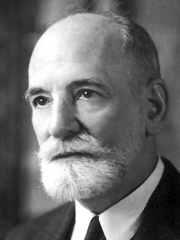
5. René Cassin (1887 - 1976)
With an HPI of 62.68, René Cassin is the 5th most famous French Social Activist. His biography has been translated into 53 different languages.
René Samuel Cassin (5 October 1887 – 20 February 1976) was a French jurist known for co-authoring the Universal Declaration of Human Rights and receiving the Nobel Peace Prize. Born in Bayonne, Cassin served as a soldier in the First World War during which he was seriously wounded. He was of Portuguese-Jewish descent. On 24 June 1940, during the Second World War, Cassin heeded General Charles de Gaulle's radio appeal and joined him in London. Cassin used his legal expertise to help de Gaulle's Free French. Between 1944 and 1959, Cassin was a member of the Council of State. Seconded to the UN Commission on Human Rights after the war, he was a major contributor to the 1948 Universal Declaration of Human Rights. For that work, he received the Nobel Peace Prize in 1968. The same year, he was awarded one of the UN General Assembly's Human Rights Prizes.

6. Louise Michel (1830 - 1905)
With an HPI of 62.53, Louise Michel is the 6th most famous French Social Activist. Her biography has been translated into 46 different languages.
Louise Michel (French: [lwiz miʃɛl] ; 29 May 1830 – 9 January 1905) was a teacher and important figure in the Paris Commune. Following her penal transportation to New Caledonia she embraced anarchism. When returning to France she emerged as an important French anarchist and went on speaking tours across Europe. The journalist Brian Doherty has called her the "French grande dame of anarchy." Her use of a black flag at a demonstration in Paris in March 1883 was also the earliest known of what would become known as the anarchy black flag.

7. Flora Tristan (1803 - 1844)
With an HPI of 61.00, Flora Tristan is the 7th most famous French Social Activist. Her biography has been translated into 28 different languages.
Flore Célestine Thérèse Henriette Tristán y Moscoso (7 April 1803 – 14 November 1844), better known as Flora Tristan, was a French-Peruvian writer and socialist activist. She made important contributions to early feminist theory, and argued that the progress of women's rights was directly related with the progress of the working class. She wrote several works, the best known of which are Peregrinations of a Pariah (1838), Promenades in London (1840), and The Workers' Union (1843). Tristan was the grandmother of the painter Paul Gauguin.

8. Simon de Montfort, 6th Earl of Leicester (1208 - 1265)
With an HPI of 60.32, Simon de Montfort, 6th Earl of Leicester is the 8th most famous French Social Activist. His biography has been translated into 38 different languages.
Simon de Montfort, 6th Earl of Leicester (c. 1208 – 4 August 1265), later sometimes referred to as Simon V de Montfort to distinguish him from his namesake relatives, was an English nobleman of French origin and a member of the English peerage, who led the baronial opposition to the rule of King Henry III of England, culminating in the Second Barons' War. Following his initial victories over royal forces, he became de facto ruler of the country, and played a major role in the constitutional development of England. During his rule, Montfort called two famous parliaments: the Oxford Parliament stripped Henry of his unlimited authority, while the second included ordinary citizens from the towns. For this reason, Montfort is regarded today as one of the progenitors of modern parliamentary democracy. As Earl of Leicester he expelled Jews from that city; as he became ruler of England he also cancelled debts owed to Jews through violent seizures of records. Montfort's party massacred the Jews of London, Worcester and Derby, killing scores of Jews from Winchester to Lincoln. After a rule of just over a year, Montfort was killed by forces loyal to the king in the Battle of Evesham.

9. Léon Jouhaux (1879 - 1954)
With an HPI of 60.05, Léon Jouhaux is the 9th most famous French Social Activist. His biography has been translated into 48 different languages.
Léon Jouhaux (1 July 1879 – 28 April 1954) was a French trade union leader who received the Nobel Peace Prize in 1951.
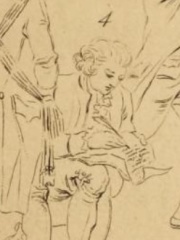
10. Jacques Roux (1752 - 1794)
With an HPI of 59.64, Jacques Roux is the 10th most famous French Social Activist. His biography has been translated into 22 different languages.
Jacques Roux (French pronunciation: [ʒak ʁu], 21 August 1752 – 10 February 1794) was a radical Roman Catholic Red priest who took an active role in politics during the French Revolution. He skillfully expounded the ideals of popular democracy and classless society to crowds of Parisian sans-culottes, working class wage earners and shopkeepers, radicalizing them into a revolutionary force. He became a leader of a popular far-left.
Pantheon has 24 people classified as social activists born between 1208 and 1966. Of these 24, 3 (12.50%) of them are still alive today. The most famous living social activists include Osman Kavala, Christine Delphy, and Dieudonné M'bala M'bala. The most famous deceased social activists include Charlotte Corday, Olympe de Gouges, and Gabrielle d'Estrées. As of April 2022, 5 new social activists have been added to Pantheon including Osman Kavala, François-Jean de la Barre, and Christine Delphy.
Living Social Activists
Go to all Rankings
Osman Kavala
1957 - Present
HPI: 51.24
Christine Delphy
1941 - Present
HPI: 48.17
Dieudonné M'bala M'bala
1966 - Present
HPI: 42.97

Deceased Social Activists
Go to all Rankings
Charlotte Corday
1768 - 1793
HPI: 72.82
Olympe de Gouges
1748 - 1793
HPI: 71.95
Gabrielle d'Estrées
1573 - 1599
HPI: 64.75
Edmond James de Rothschild
1845 - 1934
HPI: 63.99
René Cassin
1887 - 1976
HPI: 62.68
Louise Michel
1830 - 1905
HPI: 62.53
Flora Tristan
1803 - 1844
HPI: 61.00
Simon de Montfort, 6th Earl of Leicester
1208 - 1265
HPI: 60.32
Léon Jouhaux
1879 - 1954
HPI: 60.05
Jacques Roux
1752 - 1794
HPI: 59.64
Abbé Pierre
1912 - 2007
HPI: 59.02
René Just Haüy
1743 - 1822
HPI: 58.97

Newly Added Social Activists (2022)
Go to all Rankings
Osman Kavala
1957 - Present
HPI: 51.24
François-Jean de la Barre
1745 - 1766
HPI: 50.74
Christine Delphy
1941 - Present
HPI: 48.17
Joseph Wresinski
1917 - 1988
HPI: 46.97
Eugénie Cotton
1881 - 1967
HPI: 46.34

Which Social Activists were alive at the same time? This visualization shows the lifespans of the 17 most globally memorable Social Activists since 1700.

